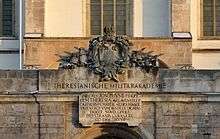Theresian Military Academy
 | |
| Motto | A.E.I.O.U. |
|---|---|
| Type | Military academy |
| Established | 14 December 1751 |
| Kommandant | Brigadier Mag. Gerhard Herke |
| Location | Wiener Neustadt, Lower Austria, Austria |
| Website | bmlv.gv.at |
The Theresian Military Academy (German: Theresianische Militärakademie, TherMilAk) is a military academy in Austria founded in 1751, where the Austrian Armed Forces train their officers. The academy is located in the castle of Wiener Neustadt in Lower Austria.
History
The Theresian Military Academy is one of the oldest military academy in the world (the oldest is the Italian Military Academy Jan 1st, 1678),[1] and was founded on 14 December 1751 by Maria Theresa of Austria who gave the first commander of the Academy, Fieldmarshal Leopold Josef Graf Daun (Lord Daun), the order "Mach er mir tüchtige Officier und rechtschaffene Männer daraus" ("Make me hard working officers and honest men"). Per year the Academy accepted 100 noblemen and 100 commoners to start their education there.[2] In 1771 Fieldmarshal Lieutenant Hannig published the official studying plan and in 1775 Maria Theresa published the Academy Rules. At this time it took 11 years to complete the Academy but step by step it was shortened to 3 years.

The Styrian Prince Erzherzog Johann (Archduke John) was the principal Headmaster of the academy for 44 years (1805–1849).
In the First Republic (1918–1938) the academy was located in Enns untll 1934 and then again in the castle of Wiener Neustadt. A very remarkable event in the time between Austrofascism and the Anschluss (Occupation of Austria by Nazi Germany) was that Lieutenant General Rudolf Towarek (Commander of the TherMilAk between 1933 and 1938) prevented the Wehrmacht from entering the castle for several days. This was the only military resistance made by Austrians against the occupation by Nazi Germany. GenLt Towarek wasn't punished for this action; he was, however, retired while retaining the right to wear the Austrian uniform after his retirement which was highly unusual in those days.
After the Anschluss the Wehrmacht installed a war school for non-commissioned officers at the castle of Wiener Neustadt. The first commander of this school was Erwin Rommel. At this time the Germans erected a new building next to the castle, which is now known as Fort Daun, in which the Military High School of Austria is located.[3]
After World War II and the Austrian State Treaty which was signed in 1955 the demolished castle was rebuilt and in 1958 the military academy was again located in Wiener Neustadt after a short intermezzo (1955–1958) in Enns.[4]
The TherMilAk today
The current commanding officer - CO (German: Kommandant - Kdt) of the TherMilAk is Brigadier Mag. Gerhard Herke.[5]
From 1997-2008 the TherMilAk was a 4-year college which can also be attended by civilian students and finishes with a master's degree in military leadership. In 2008 it was changed into a 3-year curriculum, graduating with a bachelor's degree. In 2003 the first four women completed the academy.[6] Since 1959 more than 3,600 young officers have been educated at the Theresian Military Academy.[7]
TherMilAk commanders (selection)
Below there is a selection of the commanders of the TherMilAk.
| name | rank | CO | remark |
|---|---|---|---|
| Guido Novak von Arienti | Feldmaschall-Leutnant | 1917–1919 | last imperial (kaiserlicher) commander and adge-group godfather of the 2010 graduates |
| Rudolf Towarek | Generalmajor | 1934–1938 | |
| Erwin Rommel[8] | Oberst | 1938–1939 | June 22, 1942 appointed to Generalfeldmaschall |
Second Republic
| name | rank | CO | remark |
|---|---|---|---|
| Erwin Starkl | Major | 1955–1956 | 35th CO |
| Josef Heck | Oberst | 1957–1959 | Oberst dhmD; 36th CO |
| Erich Watzek | Generalmajor | 1959–1971 | 37th CO |
| Alois Nitsch | Generalmajor | 1972–1980 | 38th CO |
| Johann Philipp | Divisionär | 1980–1984 | 39th CO |
| Adolf-Erwin Felber | Divisionär | 1985–1999 | 40th CO |
| Karl-Heinz Fitzal | Divisionär | 1999–2003 | 41st CO |
| Norbert Sinn | Generalmajor | 2003–2013 | 42nd CO |
| Gerhard Herke | Brigadier | 2013–.... | 43rd CO |
See also
Notes and references
- ↑ Fitzal, Karl-Heinz [Editor] : 250 Jahre Offiziersausbildung : Wr. Neustadt : Theresan. Militärakad. , 2002
- ↑ http://www.bmlv.gv.at/karriere/offizier/geschichte.shtml , Feb. 2009
- ↑ Allmayer-Beck, Johann Christoph : Militärakademie - Kriegsschule - Fahnenjunkerschule : Wiener Neustadt 1938 - 1945 : Bundesministerium für Landesverteidigung , 2006
- ↑ http://www.bmlv.gv.at/karriere/offizier/geschichte.shtml , Feb. 2009
- ↑ http://www.miles.ac.at/campus/news/2013/kommandouebergabe.php , Nov. 2013
- ↑ http://www.bmlv.gv.at/karriere/offizier/geschichte.shtml , Feb. 2009
- ↑ http://www.tr-wiking.at/haupt.php?seite=geschichte_milak.htm Feb.2009
- ↑ Siehe zu diesem Abschnitt: Ralf Georg Reuth: Erwin Rommel. Des Führers General. Piper, München 1987, ISBN 3-492-15222-8, S. 14–27; David Fraser: Rommel. Die Biographie. Siedler, Berlin 1995, ISBN 3-88680-559-X, S. 86–115; Maurice Philip Remy: Mythos Rommel. List, München 2002, ISBN 3-471-78572-8, S. 31–43; Das Deutsche Heer, Gliederung, Standorte, Stellenbesetzung am 3. Januar 1939, Bad Nauheim 1953.
External links
-
 Media related to Theresianische Militärakademie at Wikimedia Commons
Media related to Theresianische Militärakademie at Wikimedia Commons - http://www.bmlv.gv.at/karriere/offizier/index.shtml
Coordinates: 47°48′35″N 16°14′44″E / 47.80972°N 16.24556°E